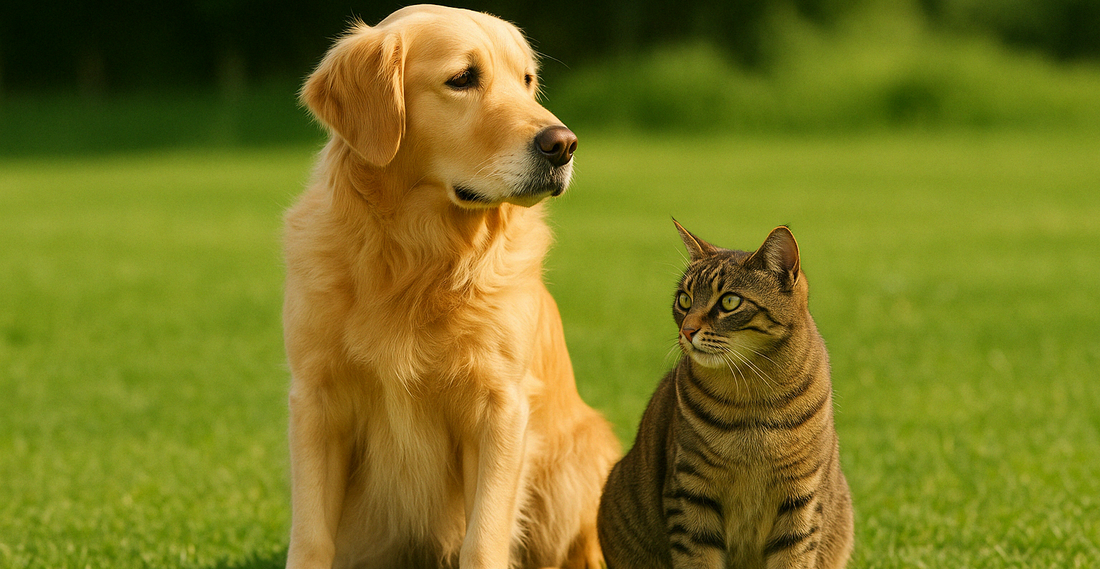
The Hidden Dangers Lurking in Your Lawn: Protecting Your Pets from Chemical Exposure
The Hidden Dangers Lurking in Your Lawn: Protecting Your Pets from Chemical Exposure
Have you ever stepped outside and wondered, "What is that chemical smell?"
Even if you don't notice it, it's often there lingering in the grass, clinging to your shoes, and coating your pet's paws. According to the EPA, over 80 million pounds of pesticides are applied to lawns annually in the United States alone. This invisible threat poses a significant risk to our beloved furry family members.
The Uncomfortable Truth About Lawn Chemicals
Even if you don't use synthetic fertilizers, weed killers, or pesticides on your own property, they're still around. Research from Purdue University has detected lawn chemicals up to 50 feet away from application sites due to drift. Your pets are likely being exposed through walks, neighborhood parks, and even your front lawn if your building or HOA uses chemical treatments.
Why Our Pets Are Particularly Vulnerable
The Science of Susceptibility
Pets have higher exposure risk than humans because they're closer to the ground, have more skin contact with treated surfaces, and don't wear protective footwear.
Canine Vulnerability
Dogs are up to 10x more sensitive to certain lawn chemicals than humans due to differences in metabolism and detoxification pathways. A 2013 study published in Science of the Total Environment found lawn pesticides in the urine of 14 out of 15 dogs tested after lawn treatments.
Feline Risk Factor
Cats face even greater danger due to their meticulous grooming habits they ingest chemicals by licking their paws and fur. Their specialized liver enzymes also process toxins differently than other mammals.
The Research Is Clear
A six-year study by Tufts University School of Veterinary Medicine found that dogs exposed to lawn chemicals had a 70% higher risk of developing canine malignant lymphoma. Common lawn chemicals like 2,4-D (found in over 1,500 lawn products) are linked to:
- Cancer (particularly lymphoma in dogs)
- Kidney and liver damage
- Neurological problems
- Endocrine disruption
- Reproductive issues
Once these chemicals are on your pet's paws or fur, they don't just stay there. A 2012 study in Environmental Research showed chemical residues can persist on pet fur for up to 48 hours after application, with higher concentrations found in dogs with longer coats.
The "Safe Chemical" Myth
The National Academy of Sciences has concluded there is no such thing as a "safe" dose for many lawn chemicals even minuscule amounts can potentially trigger biological effects. If it wasn't created by nature, it likely hasn't co-evolved with our pets' biological systems.
Practical Steps to Protect Your Pets
Create a "Paw Protocol"
According to veterinary dermatologists, wiping paws after walks can remove up to 85% of surface contaminants. Use unscented baby wipes or a damp microfiber cloth.
Timing Matters
Avoid letting pets walk on recently treated lawns for at least 48 hours the EPA notes that's when chemical residues are highest.
Go Natural
Skip chemical "weed & feed" products at home. The University of California's Integrated Pest Management Program recommends natural alternatives like corn gluten meal (pre-emergent weed control) and nematodes (for grub control).
Ask Questions
Before visiting parks or common areas, inquire about their lawn care practices. Many municipalities now offer "pesticide-free zone" designations.
Support Transparency
Choose brands committed to safety from the ground up those that disclose their full supply chain and testing protocols.
Our Commitment to Chemical-Free Pet Products
At BellePepper Cats, we maintain a zero-tolerance policy for synthetic chemicals. Our facilities are certified chemical-free, and we conduct regular third-party testing to verify no pesticide residues are present in our ingredients or final products.
We only use clean, whole food ingredients nothing synthetic, nothing hidden. Because clean treats start with a clean process. And your pets deserve better.
Treat Your Pets to Chemical-Free Goodness
Your commitment to your pet's health doesn't stop at wiping paws. What goes into their bodies matters just as much.
At BellePepper Cats, we keep it simple: No synthetics, fillers, preservatives, or artificial anything. Just 100% natural ingredients and 100% transparency. Check out some of our amazing options for cats and dogs:
Single-Ingredient Treats – Chicken heart slices, whitefish, bison liver, and more. Naturally packed with essential nutrients that support your pet’s overall wellness.
Food Toppers – Make mealtime more enticing and enriching with freeze-dried scrambled duck eggs, beef blood, and our newest topper: pumpkin—an excellent source of fiber that supports digestion and healthy stools.
Variety Packs – Our Chicken Lovers, Carnivore’s Delight, and Heart Medley packs offer a curated mix of proteins to provide both nutritional variety and enrichment for your pet.
🌱 Choose clean. Choose conscious. 🐾 Protect your health. 🐶🐱 Protect your animals. 🌍 Protect the land.
Sources:
- U.S. Environmental Protection Agency (EPA), "Pesticides Industry Sales and Usage Report" (2021)
- Purdue University Extension, "Pesticide Drift Management" (2020)
- Knapp et al., "Detection of herbicides in the urine of pet dogs following home lawn chemical application," Science of the Total Environment (2013)
- Hayes et al., "Canine malignant lymphoma and exposure to lawn care products," Journal of the American Veterinary Medical Association (2018)
- Morgan et al., "Exposure assessment of pets to lawn care chemicals," Environmental Research (2012)
- National Academy of Sciences, "Toxicity Testing in the 21st Century" (2017)
- University of California Agriculture & Natural Resources, "Integrated Pest Management for Home Lawns" (2022)
